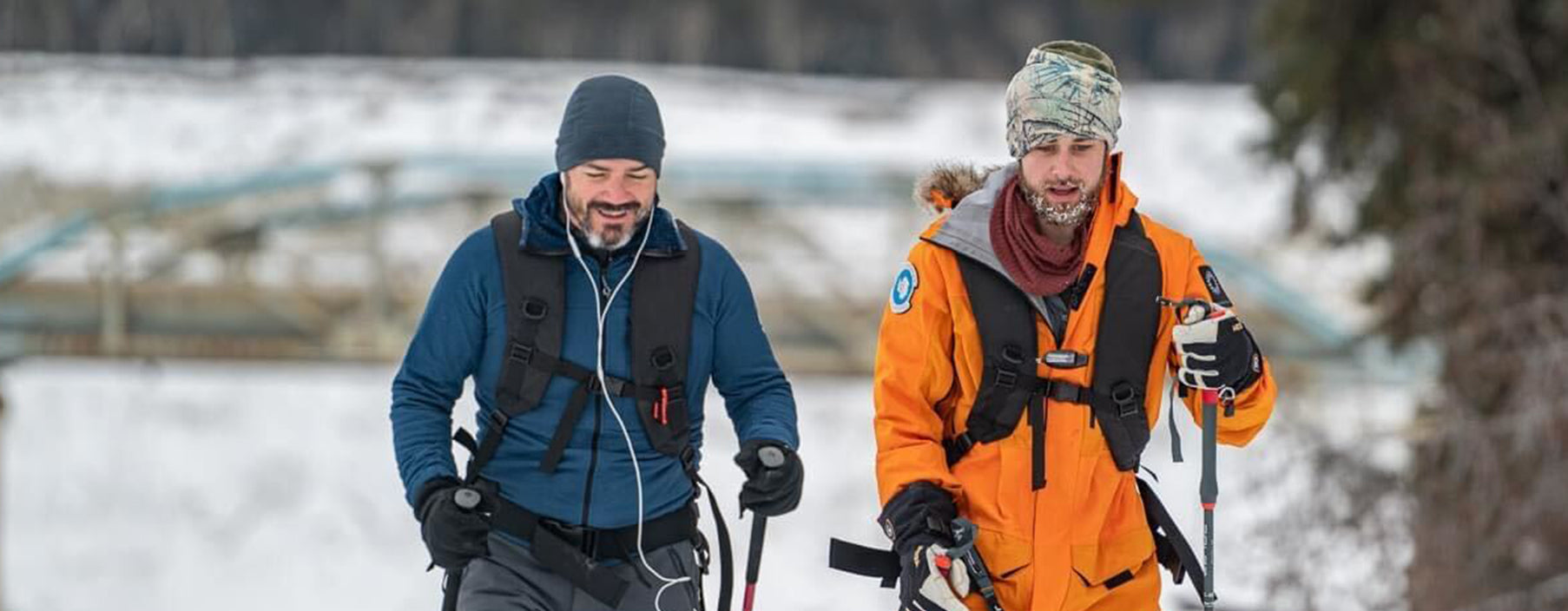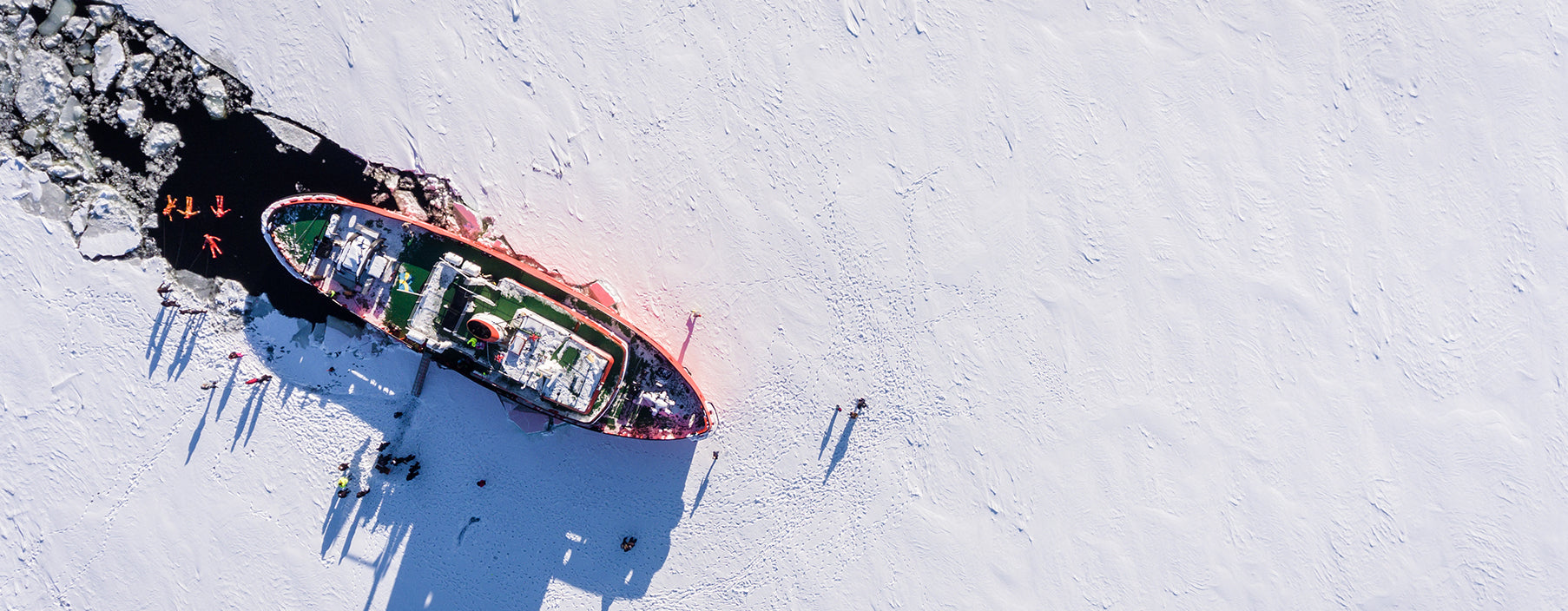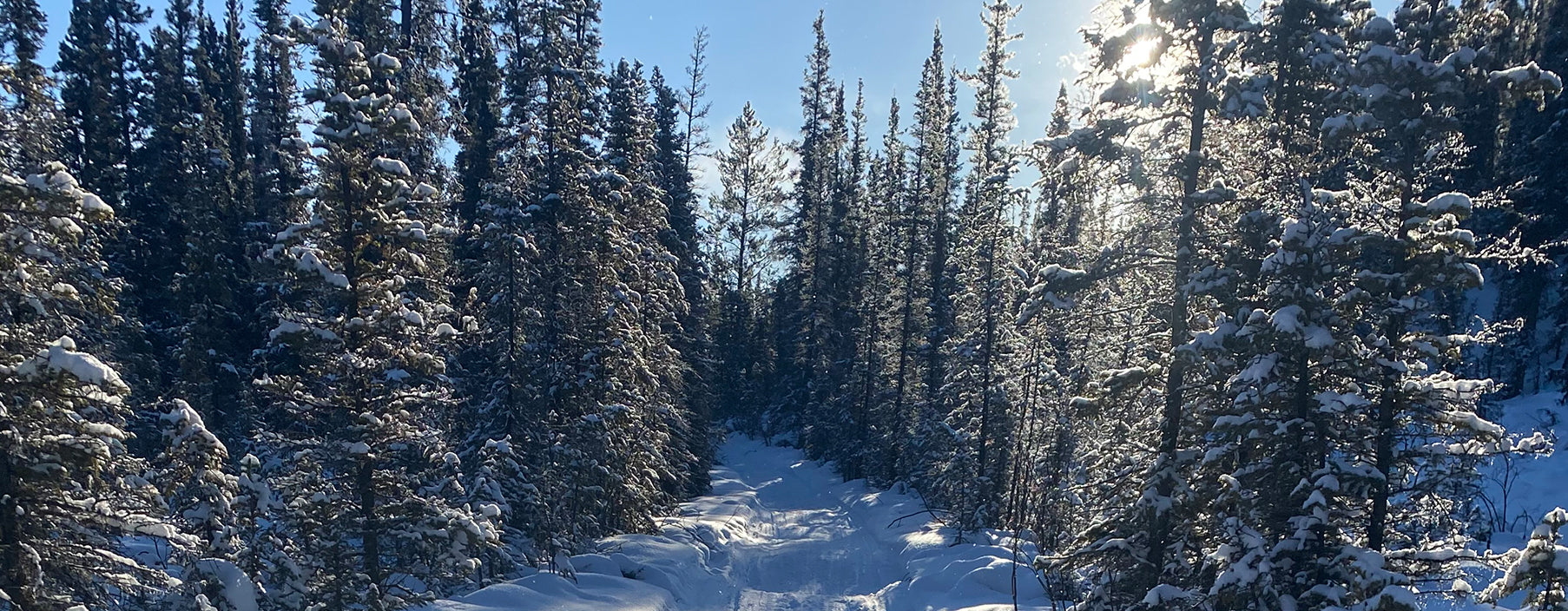
JACOB VALHALLA MYERS // The Montane Yukon Arctic Ultra (MYAU) Part 1
Jacob Valhalla Myers is an American Ultra Marathon runner living in Bozeman, Montana. This year he's aiming to be the youngest person to ever walk to the South Pole S/U/U. Having started his polar journey on the Shackleton Finse Polar Skills Challenge last year, this season he will be returning to Finse for the expedition season as a support guide for Louis Rudd and Wendy Searle. In February he took part in the gruelling Montane Yukon Arctic Ultra. This is part 1 of his expedition diary. Read part 2 HERE.

It’s Saturday, February 4th, and I find myself standing within a crowd of sleds and microspikes by the Yukon River. Waiting for the race to start felt like an eternity, but once it did the entire year of planning and training I had put into this race seemed to dissipate. Picking up my life and moving to Montana where I knew noone, all the miles ran through the mountains, the gear meticulously tested, and the Winter spent dragging my tire up Drinking Horse Mountain before I’d kneel in the creek felt like a mere instant at this point.

I stood at the front of the pack excited for the journey ahead and very confident. Robert, the race director, counted down from 10 and unleashed a mob of us onto the river as we pressed toward the first aid station. I remember feeling those first footsteps on the ice crunching under my feet as I ran to create some distance between myself and the other racers. I felt perfectly present in that moment. I think that’s one of the things I enjoy most about ultrarunning. My day-to-day life of balancing relationships and my training schedule against the permanently increasing pressure to keep my expedition to Antarctica relevant fades away, and from the moment the gun goes off until the moment I cross that finish line I live with absolute purpose. The only thing in the world that exists is forward motion.
I cruised those first 3 or so miles with Tommy Chen, and where one would expect the air to be filled with cold competitiveness, it was actually a lot more fist bumps and laughing than anything else. I asked him about how it felt running a race like this where the solitude and cold of night were quickly cut by the flash of cameras from his media team near every aid station. He said he was cool with it.
Tommy is a bit faster than me, and so the gap between us grew within the first couple hours and I lost sight of him. That’s to be expected in a race that spans more than a week, but I imagined I’d see him again. I settled into my cadence now that the excitement of the start was over and tried to focus on my strategy. “One hour at a time leads to an aid station. About one aid station per day. Enough days and I will complete the journey.”
The First Night
It felt like the gun had barely gone off by the time I reached MukTuck, but since night was going to fall soon I decided to partner up before leaving the aid station — and that’s when I met my new buddy, Brian!
Brian is a retired Canadian army dude who brings value into his life by taking on crazy difficult athletic feats. Various Triathlons, ultramarathons, and now the MYAU (which is really its own entity) make up his repertoire. The guy looks giddy when he walks. There’s a little pop in his step, and very rarely did I see him deviate from his consistent pacing. He was a man at work for sure. We chatted about the race, why we were there, future endeavors, and the millions of things you can think to share while plowing forward across a frozen river in the darkness of the Arctic Winter.
It astounds me how comfortable we can get with being uncomfortable. After the course turns off the Yukon River it cuts across a parking lot which serves as a safety net should any racers need to pull out on the first night. For us it was a place with friendly medical staff to have a laugh with while we ate our dinner and set off to finishing our first night shift. The medics poked at me for my handfuls of trail mix while Brian had a chemical-heated MRE. This was where I had my first reminder of the respect this cold environment demanded. My hands had sweat through my liner gloves, and in a matter of a minute ice began forming over the top of my knuckles. At first I was mesmerized watching frozen crystals grow in real time, but the beauty faded quickly once the sting of the Arctic’s handshake took hold of my fingers with a death grip. My hands screamed for a moment and then went numb. I pushed my knuckles together to break the thin layer of ice that now restricted me from closing my hands, threw my arms down in a windmill motion to force warm blood back into the fingertips, and stuck my hands inside my expedition down jacket against my body for a minute until I felt like I could move them well again. I was ready to go, and Brian seemed eager to take off as well, so we threw our food bags in the front of our pulks and marched into the woods.
That night felt so good. Almost too good. Brian bedded down at 2:00 AM while I wanted to press on until 4:00. I rolled up and over the endless series of forested hills that dotted this section preceding the Dog Grave Lake Aid Station. I went to bed feeling confident and not too tired. In fact, I was quite proud of the difference this 18 hours of sledging felt on my legs compared to how it would’ve felt when I first started ultrarunning two years ago.
I got up from camp quickly and tried to get moving so I wouldn’t get too cold fiddling with my bivvy and other gear. I suppose my pace had dropped to some degree in those last hours before sleeping because I had hoped to reach Dog Grave lake within an hour of waking up and felt the blows of disappointment get stronger as the sun rose as I hadn’t seen any signs of civilization. The golden rule of this race is probably the hardest to follow; “You are always further away than you think,” and boy was that true.
Dog Grave Lake came into view around 11:00 or so, and by this point Brian had caught me again and we rolled into camp excited for hot drinks, a nice meal, and a little midday rest. The medics looked over my hands and feet for any signs of frostbite or blistering, and once they gave me the ok I went about drying all my gear by the fire (I’ve got some painfully sweaty feet). Everyone at camp was in such high spirits as we all had finally got through all those rolling hills in the night.
I finished my meal, threw on some fresh socks, and made my way out of camp around 12:30. The afternoon temps were comfortable enough for me to take my pulk jacket off, and the trail was relatively uniform as it cut straight through dense forest and skirted alongside frozen lakes. My goal was to make it to Braeburn, the 100-mile checkpoint, by the following morning.
A Walk in the Woods
This time of year the Yukon has 15-hours of darkness, and that can be a lot to take in all at once. With my hood on I can only see the bouncing of my headlamp which reveals the next 15-feet of trail. The whumpfing of the snow under my feet is typically the only thing that breaks the intense silence of the Arctic night. The only sensations to keep me alert are the cold air stinging my nose and the occasional stiffening of my mouth as ice forms across my mustache and limits my range. This race, for the vast majority of my time, was an adventure into myself. Everything in the entire world ceased to exist outside of the hypnotic bouncing of my headlamp and the knowledge that the only way to maintain my body temperature was to keep moving. My headphones, old as they are, couldn’t seem to operate in the cold, and so I ventured inward during this long walk with no music or any other forms of distraction. There were powerful moments in there, some very cathartic, and some intimidating. I encourage anyone looking to step onto this course to work through whatever is necessary to get comfortable with being alone and vulnerable with themselves for a long period of time.
In order to give myself some reprieve from this intense experience, I cut my day into three shifts: Night shift 1, day shift, and night shift 2. If I get to sleep around midnight every night I can get 4-5 hours of sleep, and that means a 4-5 hour sled pull in the dark morning before the day starts. My goal during this time was solely to walk until daylight. Sometime after the sun came up I’d hit an aid station, eat a hefty meal, rehydrate, take a break, and then press on throughout the afternoon. I tried my best to spend this time with another racer if I could (ultimately, it was Brian whose pace and schedule was so similar to mine), enjoying the beauty of the Yukon, conversation and some good laughs at the end of the day. Once night set back in at around 7:30pm there was a final shift until midnight or so, leaving me with some good company in those first 5 hours of darkness.
This schedule was the intention, though once we had passed by a cabin where other racers were camped outside around 8:30 that night, Brian and I both felt like we could use some early rest after what was a surprisingly difficult afternoon in soft snow. I promised myself I’d press on until midnight anyways so I could stay on schedule, but ultimately was seduced by the thought of sleep. Sleep and food, it turned out, were two of my biggest fights throughout the race. I intended on taking in food and water every 90 minutes as cold-related injuries are more likely when dehydrated or in a calorie deficit, but I continually found myself abandoning this routine for the sake of pressing forward. In hindsight that was irresponsible, and likely a contributor to my declining pace.
I woke up at 3:00am the next morning and was on the move by 3:15. Walking through the witching hour was so interesting since I passed by so many racers sleeping on the side of the trail. Their pulks were pinned with their bib numbers, and I searched for any names I didn’t recognize. In those long seven hours until sunrise had finally breached the horizon I believe I passed by five bivvies. This shift felt like an eternity. My hands, now sweating again as I was working hard to hit the aid station, got painfully cold when I’d stop to eat and drink. It’s kind of bizarre how I got so used to the tingling in my fingertips that by the time the sun had come up and I reached Braeburn I hadn’t even realized the frost nip on my thumb. I pulled out my phone to take a picture at Braeburn and even as I was inside and warmed up I had no sensation in my thumb as I pressed the button. Now, still, I have no sensation in my right thumb, though all signs show it’ll improve in a couple more weeks. The race has a very strict no frostbite policy, but thankfully things hadn’t progressed beyond frostnip so I was in the clear. It would’ve been heartbreaking to cover 100 miles and then get pulled for a numb thumb.
Birthday Cinnamon Buns!
The volunteers were waiting for me at Braeburn with the lodge’s famous giant cinnamon buns. They stuck a sparkler in it, and my entire mood had changed upon arriving to the sound of all these amazing folks singing Happy Birthday to me as I marched toward the lodge. It was one of the sweetest gestures I could’ve hoped for, even though I kept them waiting by not arriving on my actual birthday the previous night. I’ve said it before and I’ll continue to say it about ultrarunning; you can NOT beat the amazing community that centers on events like this. Folks who have run the race 10+ times stood alongside others who would never consider attempting a feat like this. Arctic veterans of the Canadian Rangers laughed alongside a staff of medics from London, and between them were folks from as far away as Asia. These events are a great unifier where every racer and staff member wants nothing but to see everyone make it to the end.
I left Braeburn after two full meals (you wouldn’t believe how hungry I was) and a nap. The sun was beating down on me, and temps had risen to about 30 degrees fahrenheit (-1 celsius). I was moving comfortably in nothing but a base layer which is something I never thought I’d say about a race in the Arctic. Another racer who finished the 100-miler had given me his headphones which made the going so much easier here. I marched across farmland and spent the afternoon scooting on frozen lakes to the sounds of Chance the Rapper’s Acid Rap and Kendrick Lamar’s Mr. Morale & The Big Steppers. I was never a big fan of that second album in its entirety, but somewhere along those long hours of solitude I think I finally appreciated the importance of what Kendrick was saying. Sadly the headphones stopped working after those two albums. I think I’m cursed in that way.
As usual, night came quickly and those first few hours were the most definitive ones of my entire race. It took nearly two hours to traverse the lake, and I could see the line of headlamps ahead and behind me as I trudged on. Above me the night sky was dotted with the purest starlight I have ever seen, and even as the twinkling lights fell upon the horizon they transcended onto the earth itself as racers to my front and back occasionally turned their heads and illuminated the forested hillsides of the lake with their bobbing headlamps.

All the years of training, the fundraising, and planning made perfect sense as they approached their climax at this very moment. I was in a foreign landscape, one of the most remote landscapes in the world, dragging my sled along the same line of ice as all the other racers, but I was the only person on the entire planet to experience that very moment from my perspective. This moment belonged to me, and somewhere in the distance that separated me from my fellow racers were moments that belonged to them. Some of them were shared with their racing partners, and some were lived alone like mine, but none of them were identical. This experience was religious in its power and affect on my being, and I’m incredibly grateful to Robert for putting this race together and for Henry who inspired me to attempt it.
FIND OUT MORE
Read part 2 of Jacob's MYAU expedition diary HERE.
See how you can start your polar journey on the Finse Polar Skills Challenge HERE.
Follow Jacob on Instagram HERE.


